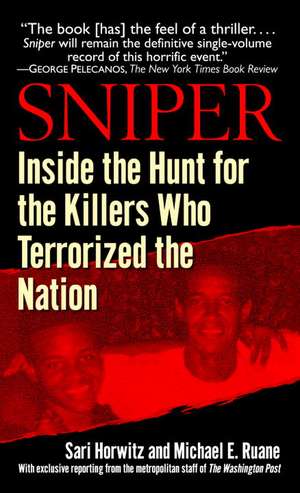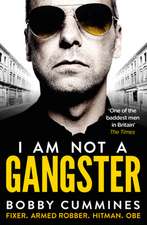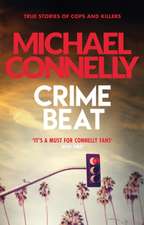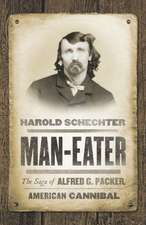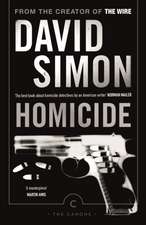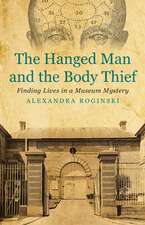Sniper: Inside the Hunt for the Killers Who Terrorized the Nation
Autor Sari Horwitz, Michael E. Ruaneen Limba Engleză Paperback – 31 aug 2004
For more than three weeks, the nation watched in disbelief as Washington, D.C., and its surrounding suburbs were held hostage by anonymous gunmen shooting innocent civilians at random. Sniper is the definitive account of those alleged gunmen, John Muhammad and Lee Boyd Malvo, and the massive manhunt that ended with their capture by a heavily armed SWAT team in an early-morning raid at an interstate highway rest stop.
Two Washington Post reporters, Sari Horwitz and Michael E. Ruane, retrace the steps of Muhammad and Malvo from their first meeting on the island of Antigua to Malvo’s defiant confession in a Virginia jail. Drawing on exclusive reporting about that confession, internal police documents, and a wide range of law-enforcement sources, Horwitz and Ruane track in remarkable detail the murderous trail Muhammad and Malvo are accused of having followed to the Washington area and reconstruct the eerie way in which the two moved invisibly around the nation’s capital in the midst of one of the largest police investigations in U.S. history.
Horwitz and Ruane also take you inside the police command center where local and state police, joined by the federal government’s most experienced crime fighters, worked desperately to stop the killings, unaware that a fundamental error—investigators were wrongly fixated on a white van—was allowing Muhammad and Malvo to slip through the dragnet. We meet FBI negotiators, veteran detectives, forensics experts, prosecutors, and politicians who faced perhaps the biggest challenge of their careers as they confronted frustrating setbacks, logistical nightmares, and the overwhelming pressure of a high-stakes investigation. In a fast-paced narrative that outdoes even the most acclaimed television cop shows, Sniper recounts the extraordinary police work that enabled investigators to quickly exploit the clues handed to them by Muhammad and Malvo that finally led to their arrest.
Part gripping drama, part real-life portrait of law enforcement at work, Sniper is also a cautionary tale about the vulnerability of American society in an age of terrorism.
From the Hardcover edition.
Preț: 53.30 lei
Nou
Puncte Express: 80
Preț estimativ în valută:
10.20€ • 10.68$ • 8.44£
10.20€ • 10.68$ • 8.44£
Carte disponibilă
Livrare economică 17-31 martie
Preluare comenzi: 021 569.72.76
Specificații
ISBN-13: 9780345476623
ISBN-10: 034547662X
Pagini: 298
Ilustrații: 2 16-P INSERTS
Dimensiuni: 107 x 175 x 23 mm
Greutate: 0.17 kg
Editura: BALLANTINE BOOKS
ISBN-10: 034547662X
Pagini: 298
Ilustrații: 2 16-P INSERTS
Dimensiuni: 107 x 175 x 23 mm
Greutate: 0.17 kg
Editura: BALLANTINE BOOKS
Notă biografică
Sari Horwitz is an investigative reporter on the metropolitan staff of The Washington Post, where she has reported on crime, education, and social services for nineteen years. She has won numerous awards, including two Pulitzer Prizes, the Robert F. Kennedy Grand Prize for reporting on the disadvantaged, and the Investigative Reporters and Editors Medal. She lives in Washington, D.C., with her husband, Bill Schultz, and daughter, Rachael.
Michael E. Ruane is a general assignment reporter on the Maryland desk of The Washington Post. He was previously a reporter for The Philadelphia Inquirer and served as the Pentagon correspondent in Knight-Ridder’s Washington bureau. He was a 1991–92 Nieman Fellow at Harvard University. He lives in Washington, D.C., with his wife, Katie Lee, and children, Emily, Julia, and Sean.
From the Hardcover edition.
Michael E. Ruane is a general assignment reporter on the Maryland desk of The Washington Post. He was previously a reporter for The Philadelphia Inquirer and served as the Pentagon correspondent in Knight-Ridder’s Washington bureau. He was a 1991–92 Nieman Fellow at Harvard University. He lives in Washington, D.C., with his wife, Katie Lee, and children, Emily, Julia, and Sean.
From the Hardcover edition.
Extras
Chapter 1
An October Evening
The bullet was the color of a new penny. It was less than an inch long and weighed about as much as a wedding ring. It left the muzzle of the rifle at a velocity of around three thousand feet per second, stabilized on its brief journey across the parking lot by six rifling grooves inside the barrel that gave it a clockwise spin.
A relatively lightweight bullet, .223 inches in diameter, it was undisturbed in its flight by wind, precipitation, or obstruction. In its wake, though, it left an unusually loud boom, in part the product of the weapon's short, sixteen-inch barrel. In hindsight, it was clearly the sound of a gunshot, though slightly muffled and missing the telltale whip snap of a rifle.
It was 6:02 p.m. on Wednesday, October 2, 2002, about an hour before sunset on another warm, dry day in Montgomery County, Maryland, the prosperous suburb just northwest of Washington, D.C. The temperature had peaked near ninety degrees at 2:00 p.m., and the area was still parched by a drought that stretched back a year.
At the Shoppers Food Warehouse in Wheaton, about ten miles from the D.C. line, a surveillance camera perched like a big gray bird over the store facade caught the bustle of evening rush hour. In silent, jerky, black-and-white video, the camera captured cars pull-ing into the supermarket parking lot and a steady stream of people walking to the entrance-commuters breaking from the outbound river of traffic to slip in a midweek market run or to grab a gallon of milk on the way home. But the camera was not the only thing scanning the parking lot that evening.
Somewhere, probably less than fifty yards away, someone peered through the tiny glass screen of a battery-powered Bushnell holographic gun sight. The sight, which looked like the screen of a tiny video game, was mounted atop a Bushmaster XM15 E2S rifle, which had been stolen from a gun shop in Tacoma, Washington, several months earlier. The shop did not yet know it had been taken.
The Bushmaster, called a "flat top" because it lacked the rifle's characteristic carrying handle, also had a bipod, a two-legged stand that could be folded under the barrel. It was the kind of setup the military's special ops people might use. Good for quick "target acquisition"-as the task of a sniper is euphemistically described. A commercial model of the military's M-16, the Bushmaster was a version of the classic American infantry rifle that has been carried from Vietnam to the Persian Gulf. But at this moment the rifle, with the logo of a coiled snake etched on the magazine well pointed from inside a beat-up Chevrolet Caprice that was stopped nearby. The car had tinted windows and a hole cut in the trunk just over its New Jersey license plate.
As the store video and the shooter focused on the lot from opposite directions, a gray 1990 Mazda pickup with a camper top and an American flag on its antenna pulled in. It waited for another vehicle to move, then turned into a parking place. A balding man in a business suit, dress shirt, and tie, with a grocery list in his pocket, got out and walked toward the supermarket. He was fifty-five, stood five feet eleven, and weighed 194 pounds. He wore glasses and carried a white handkerchief, a black pen, and a blue cell phone in a leather case. His lunch container was in the truck on the front seat. His name was James D. Martin. He worked for the federal government's National Oceanic and Atmospheric Administration (NOAA), the parent agency of the National Weather Service, and liked to stop at the market on the way home from work to get something for dinner.
Martin was a churchgoing man, a member of the PTA, and a mentor to children at an inner-city school. He was on his way from his office at NOAA headquarters in Silver Spring, about five miles south, to his home in a development, about five miles north. There was a supermarket much closer to his home. But he also had to pick up some things for his church youth group, and this store, on the corner of Georgia Avenue and Randolph Road, had great prices.
Martin had grown up poor in southeastern Missouri. He had been in the service during the Vietnam War and had worked his way through college. He had come to Washington as a young man over thirty years ago. Now he had a split-level in the suburbs with a two-car garage, a remodeled rec room decorated with Civil War memorabilia, and a dog. His eleven-year-old son, Ben, was a Boy Scout. His wife's name was Billie. She was a Scout leader and a Sunday school teacher.
On the videocamera Martin moved stiffly, as if in an old-time movie. On the little screen of the Bushnell optical gun sight, a colored target designator fixed him from behind as he walked toward the entrance to the supermarket. He strode past one parking space, then another, an easy mark walking a straight line. From the old car, the black rifle jumped, and boomed, and sent its shiny bullet across the lot. Just a whiff of burned gunpowder may have lingered in the air.
The bullet struck Martin square in the back, slicing through his suit jacket and dress shirt and leaving a tiny hole in his skin one-eighth of an inch wide, smaller than the head of a plastic push pin. It cut through vertebra T7, below his shoulder blades, and severed his spinal cord, instantly paralyzing his lower body. Slowing down, it tore a slightly upward path, perforating his aorta, the main trunk of his cardiovascular system; the pulmonary artery to his lungs; and the pericardium, the membrane surrounding his heart. There was little deflection en route and almost no fragmentation as the bullet burst through his sternum, making a hole three-quarters of an inch by one-half inch shaped like a piece of broken glass. Later, at the autopsy, the medical examiners would find on his neck a tiny shard of gray metal that looked like lead.
Martin began to fall as soon as his spinal cord was cut. The catastrophic drop in blood pressure caused by his other wounds would have then led to swift unconsciousness. The brain carries only about a ten-second reserve of oxygen. A witness heard him moan and saw him crumple onto his left side, losing his glasses. He struck his face on the blacktop, gashing his nose and forehead. No one noticed the Caprice with the New Jersey license plate slip back into the evening rush and disappear.
A few parking places away, Kimberly Sadelson, a title clerk at a local car dealership, was loading groceries into her Honda when she heard the boom and saw Martin go down. She had her five-year-old son, Joseph, with her and hesitated to go near. She heard a woman scream and a man yell for someone to dial 911. From her cell phone Sadelson made the call.
"I'm at Shoppers Food Warehouse on Randolph Road," she said when a dispatcher answered. "And a man just fell in the parking lot. There was a loud noise. But we're not sure if he was shot."
"Okay, is he bleeding?" the dispatcher asked.
"Yes," she said.
"Where's he bleeding from?"
"I don't know," she said, her voice fearful and a little irritated. "I'm like half an aisle away from him."
"Is it inside?" the dispatcher asked.
"No," she said. "It's outside in a parking lot."
Across a busy road from the supermarket, Alan Felsen, a Montgomery County police officer, had also heard the boom. He had spent most of the day on bicycle patrol in a nearby business district but had been assigned to spend the last hour of his shift patrolling in one of the county's Impala cruisers.
Still dressed in his summer uniform-black shorts and light brown polo shirt with police on the back-Felsen had just pulled out of the parking lot of the Fourth District police headquarters, across the street from the supermarket. He had cut through an apartment complex and was waiting to pull into traffic when he heard the noise. He had his windows down, but the sound didn't register right away as a gunshot. It was missing the edge, the crack, of a firearm. It had clearly come from the supermarket parking lot.
For several seconds Felsen looked across the street toward the source of the sound, but he saw nothing. No commotion. No running. No screaming. He wondered if someone had dropped something large, a loaded pallet, maybe, at the gardening store beside the supermarket.
Then he pulled into the traffic, flicked on his emergency dome lights, and made a U-turn into the parking lot. He found people there frozen, standing, as if in a weird painting. He pulled up to the nearest bystander and called out the window: "What happened?" No response. "What's going on here?" Then, out of the corner of his eye, he spotted a figure prone in the parking lot. He realized what he had heard. He grabbed his radio and yelled, "Break, break, break!" to get through the other transmissions. "Six-King-thirteen!" he said, using his call sign. "I'm at Shoppers Food Warehouse on Randolph. I've got the sound of a shot. One down."
After getting out of his cruiser, he paused for a split second to look around, then jogged to the victim. "Did anyone see anything?" he yelled over his shoulder. People were still frozen. "Anyone who heard the shot needs to stay here," he shouted. Felsen wondered for a moment if this might be a suicide. He needed witnesses.
About an hour earlier, a call had gone over the radio about a shooting in another shopping center a few miles away in Aspen Hill. A bullet had gone through the window of an arts and crafts store called Michaels. It had struck one of the store's illuminated checkout numbers, the number 5. But the holes were almost seven feet up, and no one had been hit. Felsen thought it probably wasn't related.
Felsen called to the man on the ground to see if he was conscious. There was no reply. He knelt beside him. Martin's chest, shirt, and suit coat were soaked with blood, and pressing Martin's neck for a pulse, he felt nothing. Martin wasn't breathing, either. Though he had never seen a gunshot wound this bad, Felsen was a former volunteer firefighter and had witnessed some bad accidents. He pulled on a pair of latex gloves and began CPR chest compressions. It quickly became a bloody business.
From the crowd of bystanders, a woman asked: "Can I help?"
Felsen looked up. By chance, it was a friend, Marjorie Fiske, a local volunteer EMT Felsen had known when they were both county police dispatchers. Fiske had been a few yards away, loading her car outside the store, when she noticed the commotion.
"Margie," Felsen called, "go get my first-aid bag."
Fiske ran to Felsen's cruiser but couldn't find his kit. So she went to her car and got the first-aid bag she always carried with her. Together, they worked on Martin, trying to get a pulse back. As Felsen did the compressions, Fiske placed two pieces of gauze over Martin's mouth. She pinched his nose shut and began blowing air into his lungs. She could hear gurgling inside. A nurse stepped out of the crowd and joined the effort.
The nurse pulled Fiske's big trauma scissors from her bag and cut open Martin's shirt. Underneath was a huge clot of blood and a hole in his chest. The trio used more gauze on his chest to try to stem the blood. Already his shirt, tie, and coat were soaked, and blood was streaming across the parking lot.
More police arrived from the district headquarters across the street. Paramedics from the fire station next door to it also arrived and took over from Felsen. Felsen peeled off his gloves, washed his arms with gauze and disinfectant, and watched as they worked on Martin.
It was almost sunset. Minutes passed, and after a while, the paramedics gave up. They placed a sheet over Martin, who lay on his back in the soft light of the evening, his feet and hands sticking out.
Fiske, too, had stepped back. "Can I get out of here?" she said, shaken and worried about getting to a function at her son's high school down the road.
Felsen wondered what could have happened. Guy walking across a parking lot. A gunshot. Guy goes down with a through-and-through wound. No robbery. No carjacking. Nobody sees anything. Probably some kind of rifle involved. Felsen thought it was an accident. Somebody popped off in a neighborhood nearby, and the high-powered bullet found this poor man. What else could it have been?
Across the sprawling county, the usual calls were going out to the people who were notified when there was a homicide. One of the first was to Detective Patrick McNerney of the department's Major Crimes Division, Homicide/Sex Section. McNerney was working the 2:00-to-11:00 shift out of Montgomery County police headquarters, a nondescript redbrick office building set among scores of other nondescript office buildings in the bland office park landscape just west of the county seat of Rockville.
McNerney, a seventeen-year veteran of the department and the son of a retired federal judge, took the phone call from the department's communications center. There had been an "0100," a homicide, at a Wheaton supermarket. The victim had been shot. McNerney, an imposing blond-haired man who often wore a blue tie with shamrocks on it, was light on cases. This one was his: He would put it on like a jacket and wear it until it was over, for as long as it took. He alerted an evidence collection team, and they headed for the scene.
As they maneuvered through the traffic with lights and sirens, they crossed a county that epitomized the vast changes that had overtaken the once serene postagricultural life of the Washington suburbs. The rural enclave where Confederate general J. E. B. Stuart passed through on the way to Gettysburg began its transformation after World War II. More than a half century later, there were still farms, but much of Montgomery County was highly developed and affluent, with growing communities of Asian, Hispanic, and African immigrants. Its population had grown to over 870,000-substantially more, it boasted, than Baltimore's. Its citizens were generally safe and content. Traffic congestion was the chief worry. The county had seen only twenty murders so far in 2002, not counting Martin's. There had been forty-seven traffic fatalities.
Arriving at the supermarket parking lot, McNerney found the typical crime scene circus. Martin was on his back under a sheet. He had what to the medics looked like a nasty chest wound. Customers were going in and out of the Shoppers Warehouse, but a crowd of bystanders-"looky-loos," McNerney called them-had gathered, drawn by the TV trucks. McNerney's job was to slow the scene down, "stop time," if you will. Nobody in, nobody out. Then take it frame by frame. Nail down who was where, who saw what, who heard what. He had an investigator with a camera start taking pictures of everybody around. You never knew who might turn up.
From the Hardcover edition.
An October Evening
The bullet was the color of a new penny. It was less than an inch long and weighed about as much as a wedding ring. It left the muzzle of the rifle at a velocity of around three thousand feet per second, stabilized on its brief journey across the parking lot by six rifling grooves inside the barrel that gave it a clockwise spin.
A relatively lightweight bullet, .223 inches in diameter, it was undisturbed in its flight by wind, precipitation, or obstruction. In its wake, though, it left an unusually loud boom, in part the product of the weapon's short, sixteen-inch barrel. In hindsight, it was clearly the sound of a gunshot, though slightly muffled and missing the telltale whip snap of a rifle.
It was 6:02 p.m. on Wednesday, October 2, 2002, about an hour before sunset on another warm, dry day in Montgomery County, Maryland, the prosperous suburb just northwest of Washington, D.C. The temperature had peaked near ninety degrees at 2:00 p.m., and the area was still parched by a drought that stretched back a year.
At the Shoppers Food Warehouse in Wheaton, about ten miles from the D.C. line, a surveillance camera perched like a big gray bird over the store facade caught the bustle of evening rush hour. In silent, jerky, black-and-white video, the camera captured cars pull-ing into the supermarket parking lot and a steady stream of people walking to the entrance-commuters breaking from the outbound river of traffic to slip in a midweek market run or to grab a gallon of milk on the way home. But the camera was not the only thing scanning the parking lot that evening.
Somewhere, probably less than fifty yards away, someone peered through the tiny glass screen of a battery-powered Bushnell holographic gun sight. The sight, which looked like the screen of a tiny video game, was mounted atop a Bushmaster XM15 E2S rifle, which had been stolen from a gun shop in Tacoma, Washington, several months earlier. The shop did not yet know it had been taken.
The Bushmaster, called a "flat top" because it lacked the rifle's characteristic carrying handle, also had a bipod, a two-legged stand that could be folded under the barrel. It was the kind of setup the military's special ops people might use. Good for quick "target acquisition"-as the task of a sniper is euphemistically described. A commercial model of the military's M-16, the Bushmaster was a version of the classic American infantry rifle that has been carried from Vietnam to the Persian Gulf. But at this moment the rifle, with the logo of a coiled snake etched on the magazine well pointed from inside a beat-up Chevrolet Caprice that was stopped nearby. The car had tinted windows and a hole cut in the trunk just over its New Jersey license plate.
As the store video and the shooter focused on the lot from opposite directions, a gray 1990 Mazda pickup with a camper top and an American flag on its antenna pulled in. It waited for another vehicle to move, then turned into a parking place. A balding man in a business suit, dress shirt, and tie, with a grocery list in his pocket, got out and walked toward the supermarket. He was fifty-five, stood five feet eleven, and weighed 194 pounds. He wore glasses and carried a white handkerchief, a black pen, and a blue cell phone in a leather case. His lunch container was in the truck on the front seat. His name was James D. Martin. He worked for the federal government's National Oceanic and Atmospheric Administration (NOAA), the parent agency of the National Weather Service, and liked to stop at the market on the way home from work to get something for dinner.
Martin was a churchgoing man, a member of the PTA, and a mentor to children at an inner-city school. He was on his way from his office at NOAA headquarters in Silver Spring, about five miles south, to his home in a development, about five miles north. There was a supermarket much closer to his home. But he also had to pick up some things for his church youth group, and this store, on the corner of Georgia Avenue and Randolph Road, had great prices.
Martin had grown up poor in southeastern Missouri. He had been in the service during the Vietnam War and had worked his way through college. He had come to Washington as a young man over thirty years ago. Now he had a split-level in the suburbs with a two-car garage, a remodeled rec room decorated with Civil War memorabilia, and a dog. His eleven-year-old son, Ben, was a Boy Scout. His wife's name was Billie. She was a Scout leader and a Sunday school teacher.
On the videocamera Martin moved stiffly, as if in an old-time movie. On the little screen of the Bushnell optical gun sight, a colored target designator fixed him from behind as he walked toward the entrance to the supermarket. He strode past one parking space, then another, an easy mark walking a straight line. From the old car, the black rifle jumped, and boomed, and sent its shiny bullet across the lot. Just a whiff of burned gunpowder may have lingered in the air.
The bullet struck Martin square in the back, slicing through his suit jacket and dress shirt and leaving a tiny hole in his skin one-eighth of an inch wide, smaller than the head of a plastic push pin. It cut through vertebra T7, below his shoulder blades, and severed his spinal cord, instantly paralyzing his lower body. Slowing down, it tore a slightly upward path, perforating his aorta, the main trunk of his cardiovascular system; the pulmonary artery to his lungs; and the pericardium, the membrane surrounding his heart. There was little deflection en route and almost no fragmentation as the bullet burst through his sternum, making a hole three-quarters of an inch by one-half inch shaped like a piece of broken glass. Later, at the autopsy, the medical examiners would find on his neck a tiny shard of gray metal that looked like lead.
Martin began to fall as soon as his spinal cord was cut. The catastrophic drop in blood pressure caused by his other wounds would have then led to swift unconsciousness. The brain carries only about a ten-second reserve of oxygen. A witness heard him moan and saw him crumple onto his left side, losing his glasses. He struck his face on the blacktop, gashing his nose and forehead. No one noticed the Caprice with the New Jersey license plate slip back into the evening rush and disappear.
A few parking places away, Kimberly Sadelson, a title clerk at a local car dealership, was loading groceries into her Honda when she heard the boom and saw Martin go down. She had her five-year-old son, Joseph, with her and hesitated to go near. She heard a woman scream and a man yell for someone to dial 911. From her cell phone Sadelson made the call.
"I'm at Shoppers Food Warehouse on Randolph Road," she said when a dispatcher answered. "And a man just fell in the parking lot. There was a loud noise. But we're not sure if he was shot."
"Okay, is he bleeding?" the dispatcher asked.
"Yes," she said.
"Where's he bleeding from?"
"I don't know," she said, her voice fearful and a little irritated. "I'm like half an aisle away from him."
"Is it inside?" the dispatcher asked.
"No," she said. "It's outside in a parking lot."
Across a busy road from the supermarket, Alan Felsen, a Montgomery County police officer, had also heard the boom. He had spent most of the day on bicycle patrol in a nearby business district but had been assigned to spend the last hour of his shift patrolling in one of the county's Impala cruisers.
Still dressed in his summer uniform-black shorts and light brown polo shirt with police on the back-Felsen had just pulled out of the parking lot of the Fourth District police headquarters, across the street from the supermarket. He had cut through an apartment complex and was waiting to pull into traffic when he heard the noise. He had his windows down, but the sound didn't register right away as a gunshot. It was missing the edge, the crack, of a firearm. It had clearly come from the supermarket parking lot.
For several seconds Felsen looked across the street toward the source of the sound, but he saw nothing. No commotion. No running. No screaming. He wondered if someone had dropped something large, a loaded pallet, maybe, at the gardening store beside the supermarket.
Then he pulled into the traffic, flicked on his emergency dome lights, and made a U-turn into the parking lot. He found people there frozen, standing, as if in a weird painting. He pulled up to the nearest bystander and called out the window: "What happened?" No response. "What's going on here?" Then, out of the corner of his eye, he spotted a figure prone in the parking lot. He realized what he had heard. He grabbed his radio and yelled, "Break, break, break!" to get through the other transmissions. "Six-King-thirteen!" he said, using his call sign. "I'm at Shoppers Food Warehouse on Randolph. I've got the sound of a shot. One down."
After getting out of his cruiser, he paused for a split second to look around, then jogged to the victim. "Did anyone see anything?" he yelled over his shoulder. People were still frozen. "Anyone who heard the shot needs to stay here," he shouted. Felsen wondered for a moment if this might be a suicide. He needed witnesses.
About an hour earlier, a call had gone over the radio about a shooting in another shopping center a few miles away in Aspen Hill. A bullet had gone through the window of an arts and crafts store called Michaels. It had struck one of the store's illuminated checkout numbers, the number 5. But the holes were almost seven feet up, and no one had been hit. Felsen thought it probably wasn't related.
Felsen called to the man on the ground to see if he was conscious. There was no reply. He knelt beside him. Martin's chest, shirt, and suit coat were soaked with blood, and pressing Martin's neck for a pulse, he felt nothing. Martin wasn't breathing, either. Though he had never seen a gunshot wound this bad, Felsen was a former volunteer firefighter and had witnessed some bad accidents. He pulled on a pair of latex gloves and began CPR chest compressions. It quickly became a bloody business.
From the crowd of bystanders, a woman asked: "Can I help?"
Felsen looked up. By chance, it was a friend, Marjorie Fiske, a local volunteer EMT Felsen had known when they were both county police dispatchers. Fiske had been a few yards away, loading her car outside the store, when she noticed the commotion.
"Margie," Felsen called, "go get my first-aid bag."
Fiske ran to Felsen's cruiser but couldn't find his kit. So she went to her car and got the first-aid bag she always carried with her. Together, they worked on Martin, trying to get a pulse back. As Felsen did the compressions, Fiske placed two pieces of gauze over Martin's mouth. She pinched his nose shut and began blowing air into his lungs. She could hear gurgling inside. A nurse stepped out of the crowd and joined the effort.
The nurse pulled Fiske's big trauma scissors from her bag and cut open Martin's shirt. Underneath was a huge clot of blood and a hole in his chest. The trio used more gauze on his chest to try to stem the blood. Already his shirt, tie, and coat were soaked, and blood was streaming across the parking lot.
More police arrived from the district headquarters across the street. Paramedics from the fire station next door to it also arrived and took over from Felsen. Felsen peeled off his gloves, washed his arms with gauze and disinfectant, and watched as they worked on Martin.
It was almost sunset. Minutes passed, and after a while, the paramedics gave up. They placed a sheet over Martin, who lay on his back in the soft light of the evening, his feet and hands sticking out.
Fiske, too, had stepped back. "Can I get out of here?" she said, shaken and worried about getting to a function at her son's high school down the road.
Felsen wondered what could have happened. Guy walking across a parking lot. A gunshot. Guy goes down with a through-and-through wound. No robbery. No carjacking. Nobody sees anything. Probably some kind of rifle involved. Felsen thought it was an accident. Somebody popped off in a neighborhood nearby, and the high-powered bullet found this poor man. What else could it have been?
Across the sprawling county, the usual calls were going out to the people who were notified when there was a homicide. One of the first was to Detective Patrick McNerney of the department's Major Crimes Division, Homicide/Sex Section. McNerney was working the 2:00-to-11:00 shift out of Montgomery County police headquarters, a nondescript redbrick office building set among scores of other nondescript office buildings in the bland office park landscape just west of the county seat of Rockville.
McNerney, a seventeen-year veteran of the department and the son of a retired federal judge, took the phone call from the department's communications center. There had been an "0100," a homicide, at a Wheaton supermarket. The victim had been shot. McNerney, an imposing blond-haired man who often wore a blue tie with shamrocks on it, was light on cases. This one was his: He would put it on like a jacket and wear it until it was over, for as long as it took. He alerted an evidence collection team, and they headed for the scene.
As they maneuvered through the traffic with lights and sirens, they crossed a county that epitomized the vast changes that had overtaken the once serene postagricultural life of the Washington suburbs. The rural enclave where Confederate general J. E. B. Stuart passed through on the way to Gettysburg began its transformation after World War II. More than a half century later, there were still farms, but much of Montgomery County was highly developed and affluent, with growing communities of Asian, Hispanic, and African immigrants. Its population had grown to over 870,000-substantially more, it boasted, than Baltimore's. Its citizens were generally safe and content. Traffic congestion was the chief worry. The county had seen only twenty murders so far in 2002, not counting Martin's. There had been forty-seven traffic fatalities.
Arriving at the supermarket parking lot, McNerney found the typical crime scene circus. Martin was on his back under a sheet. He had what to the medics looked like a nasty chest wound. Customers were going in and out of the Shoppers Warehouse, but a crowd of bystanders-"looky-loos," McNerney called them-had gathered, drawn by the TV trucks. McNerney's job was to slow the scene down, "stop time," if you will. Nobody in, nobody out. Then take it frame by frame. Nail down who was where, who saw what, who heard what. He had an investigator with a camera start taking pictures of everybody around. You never knew who might turn up.
From the Hardcover edition.
Recenzii
"A good deal of new information...By the end...I was sorry to have to stop reading–always a good sign." -The Washington Post
From the Hardcover edition.
From the Hardcover edition.
Descriere
This explosive behind-the-scenes account of the manhunt for and capture of the killers who terrorized the nation's capital in the fall of 2002 is written by a duo of veteran "Washington Post" reporters who covered the story as it unfolded. Now revised with a new Afterword with up-to-date coverage of the trials.
